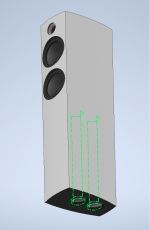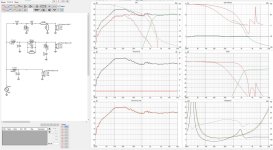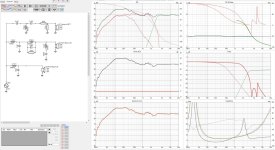Maybe instead of circular cutout, make some optimized plate for tweeter and then flush mount with rather thin basotect or melamine. Instead of cutting odd shape tweeterplate, painters tape would do as shaping of the plate doubling as near perfect transition from tweeter plate to basotect.
I guess we already have best practice (optimize placement of drivers, big round overs or facets), but sometimes experiments yield rather interesting knowledge.
Who would for example think that small flap in front of front wheel generally improve airflow…. (And less dirt)
I guess we already have best practice (optimize placement of drivers, big round overs or facets), but sometimes experiments yield rather interesting knowledge.
Who would for example think that small flap in front of front wheel generally improve airflow…. (And less dirt)
Those measurements are very telling but it takes 1/2" felt blocks around 3 sides of the tweeter and it obviously helps but who wants 1/2" wool felt around their tweeters?? Then you have to cover it with a grill so you can't see how ugly it is, which will cause more problems then the original diffraction.
After 2 years only 🙂, I've finished my first speaker protype with a ptt6.5x04-nfa, two Dayton Dsa215-pr and a Bliesma t25b-6 in @augerpro waveguide.
Simple black because they are near a projector screen.

The choice of the drivers aren't original but it's very promising.
The 2 PR on the sides and the ptt6.5 are screwed on a inner box with internal bracing.
A second box is build on top without hard connexion.
It's glued with polyurethane mastic Sykaflex and a sheet of alu butyl.
The waveguide sites on the outer box.

This is a side hole where we can see the 2 boxes.
I hope I'ill share the measurements after the vacations and I can compare this build with a "simple" box.


Simple black because they are near a projector screen.
The choice of the drivers aren't original but it's very promising.
The 2 PR on the sides and the ptt6.5 are screwed on a inner box with internal bracing.
A second box is build on top without hard connexion.
It's glued with polyurethane mastic Sykaflex and a sheet of alu butyl.
The waveguide sites on the outer box.
This is a side hole where we can see the 2 boxes.
I hope I'ill share the measurements after the vacations and I can compare this build with a "simple" box.
Very nicely done neutrino_th! I can assure you based on my experiences with Purifi drivers that extra design and fabrication work you invested in your dual layer enclosure will pay off. The PTT woofers are what I have come to regard as 'tricksters'. But it is a nice trick. Specifically they are so good a simple MDF enclosure sized correctly with a good tweeter and crossover and they will sound great from first listen. the tricky bit is that ease of implementation tends to lull us into believing we have the full measure of performance when more is hidden. In my experience over multiple designs using PTT6.5 and PTT5.25 every time the enclosure system is made stiffer, more inert, and damped one learns the driver has more to give.
Thanks for your feedback @Norman Tracy
I'll hope your right because this is the first time I make this 2 boxes build.
I think this is not a true constraint layer damping, CLD because I haven't tested extensively with various thickness and damping materials.
Sure it will not be bad but I don't know yet if optimal and the extra work worth it.
I have to check if the recessed for the ptt6.5 doesn't affect to much the upper FR
I'll hope your right because this is the first time I make this 2 boxes build.
I think this is not a true constraint layer damping, CLD because I haven't tested extensively with various thickness and damping materials.
Sure it will not be bad but I don't know yet if optimal and the extra work worth it.
I have to check if the recessed for the ptt6.5 doesn't affect to much the upper FR
seek a width so that the diffraction bump does not coincide with a spl bump of the driver
I have not mastered Vituixcad yet. But I did get WinISD Pro up and running. Although the Purifi team are on Summer holiday, they kindly sent me the Thiele-Small parameters for the 10-inch passive radiators. So, the subs design is finalised and MDF is on hand for sub cabinets that are 60cm high and 40cm wide and 40cm deep. Should yield 60L.
Midrange 6.5-inch 4-Ohm drivers with matching passive radiators are also in hand now. The Purifi SPK16 and March Sointuva’s seem a bit tall to me. I’d like to get the mids and the tweeters closer vertically for imaging in my room if I can do so with a solid cabinet structure. I have 36cm high on paper now. Maybe higher will be needed depending on tweeter wave guide sizes.
Still,if 36cm high, I could have either of the following for 16L internally:
- 25cm wide like others do and then 36cm deep, matching the height, or
- 30cm wide and 30cm deep... so width equals depth like for the subs.
Thanks again all for advice and for patience with a newbie.
PS: I failed to take tape measurements of the SPK16’s at the Munich show. But given all the rounding and all the internal latticework, can they really be 22L inside?
Last edited:
Literally just waiting for the tweeter 😁 Purifi amp ready, purifi speakers - missing 😁
Dear fellow passionate builders,
I am planning sometime next month to make a purchase of 4 x PTT6.5X08-NFA-01 and a pair of tweeters, I'm thinking about a Viawave SRT7 but I would love to go full Purifi and get the new Purifi tweeter. I wish to build a 2.5 way small tower. This will be a kind of a pilot testing build, since in the long run, I plan to build a much bigger tower. I attached 3 photos. 1 for the 3D model, the cabinet will have around 55 liters, 2 ports 7.5cm in diameter with 40 cm length firing downwards. This would equate to a 32.5 Hz tuning and a theoretical response of f3 = 31.7 Hz and f6 = 28.3 Hz, but I'm thinking of tuning it a bit lower, testing will dictate the final result. The other 2 photos are some simulations for the crossover, V2 having a matching GD & Phase plot for the bass/midrange driver and tweeter. The response I am looking for is a sort of a downward slope towards the 20k Hz, equating to a more warm sound signature.
What do you guys think?! What looks good, what doesn't? Any kind of feedback is highly appreciated! Thank you !
I am planning sometime next month to make a purchase of 4 x PTT6.5X08-NFA-01 and a pair of tweeters, I'm thinking about a Viawave SRT7 but I would love to go full Purifi and get the new Purifi tweeter. I wish to build a 2.5 way small tower. This will be a kind of a pilot testing build, since in the long run, I plan to build a much bigger tower. I attached 3 photos. 1 for the 3D model, the cabinet will have around 55 liters, 2 ports 7.5cm in diameter with 40 cm length firing downwards. This would equate to a 32.5 Hz tuning and a theoretical response of f3 = 31.7 Hz and f6 = 28.3 Hz, but I'm thinking of tuning it a bit lower, testing will dictate the final result. The other 2 photos are some simulations for the crossover, V2 having a matching GD & Phase plot for the bass/midrange driver and tweeter. The response I am looking for is a sort of a downward slope towards the 20k Hz, equating to a more warm sound signature.
What do you guys think?! What looks good, what doesn't? Any kind of feedback is highly appreciated! Thank you !
Attachments
In my experience, 55 liters is way too much for these drivers. I have a build with 2 of these woofers in a 32 liter ported enclosure and even that is too big. I used a bunch of stuffing to try and properly damp the woofers. I would make the enclosure around 20-24 liters and then design the ports based on that with a program that can simulate how to best maximize the low end extension. I wouldn't try to tune these as low as you're doing. They might go that low but they don't do it very loudly and it severely limits the overall performance. Keep them tuned around 45-50Hz and you will get much better output.Dear fellow passionate builders,
I am planning sometime next month to make a purchase of 4 x PTT6.5X08-NFA-01 and a pair of tweeters, I'm thinking about a Viawave SRT7 but I would love to go full Purifi and get the new Purifi tweeter. I wish to build a 2.5 way small tower. This will be a kind of a pilot testing build, since in the long run, I plan to build a much bigger tower. I attached 3 photos. 1 for the 3D model, the cabinet will have around 55 liters, 2 ports 7.5cm in diameter with 40 cm length firing downwards. This would equate to a 32.5 Hz tuning and a theoretical response of f3 = 31.7 Hz and f6 = 28.3 Hz, but I'm thinking of tuning it a bit lower, testing will dictate the final result. The other 2 photos are some simulations for the crossover, V2 having a matching GD & Phase plot for the bass/midrange driver and tweeter. The response I am looking for is a sort of a downward slope towards the 20k Hz, equating to a more warm sound signature.
What do you guys think?! What looks good, what doesn't? Any kind of feedback is highly appreciated! Thank you !
https://ptt.purifi-audio.com/shop/ptt6-5x08-nfa-01-ptt6-5x08-nfa-01-290
Per element:
Per element:
| Typical corner frequency, bass reflex PTT alignment | 38.2Hz |
| Box resonance, bass reflex PTT alignment | 40.5Hz |
| Box volume, bass reflex PTT alignment | 16.3L |
| Port diameter, bass reflex PTT alignment | 6.5cm |
| Port length, bass reflex PTT alignment | 37.1cm |
Thanks for the replies!
I see you have concerns regarding enclosure resonance tuning and enclosure volume. I am looking for an extended frequency response, ideally an F3 of 30 Hz. Not necessarily interested in achieving high SPL values, this being the reason for such a low tuned enclosure. What do you reckon would be the downsides of such a low tuning frequency besides the lower SPL in the 40-60Hz area? Should I be worried about the group delay becoming too high and ending up with an enclosure that sounds boomy and lazy? According to simulations, the response with a tuning frequency of ~ 31 Hz is pretty linear and in-line with what i'm looking for.
I see you have concerns regarding enclosure resonance tuning and enclosure volume. I am looking for an extended frequency response, ideally an F3 of 30 Hz. Not necessarily interested in achieving high SPL values, this being the reason for such a low tuned enclosure. What do you reckon would be the downsides of such a low tuning frequency besides the lower SPL in the 40-60Hz area? Should I be worried about the group delay becoming too high and ending up with an enclosure that sounds boomy and lazy? According to simulations, the response with a tuning frequency of ~ 31 Hz is pretty linear and in-line with what i'm looking for.
While you can get an F3 of 30Hz, you will have a much lower maximum output below 50Hz on these drivers. I don't have my PC with Basta to simulate but tuning these woofers that low means that you will reach max excursion very easy. They still sound amazing and are the best woofers I've used but I think they operate much better in smaller enclosure tuned higher. They are not a subwoofer. I have two different builds (one with dual 8 ohm woofers and one with the 4 ohm version). If I built them again I would make the cabinet smaller for each one and tune the woofer higher. Tuning them lower makes them less efficient and they have a much lower maximum SPL below 50Hz. I recommend getting a program like Basta (it's free) and simulating it. The downside of tuning an enclosure that low is that the woofer can be underdamped. I have literally done just that with these woofers. It's deceiving how well they do in small enclosures and I think they sound much better. They certainly measure better in a smaller enclosure.
Another option would be to have the woofers in their own separate enclosures and tune the differently, say one to 32 Hz, the other to 38 Hz. This way, I'm thinking I'd get the best of both worlds in terms of response and SPL. What do you think about this approach? Maybe time alignment issues would become a reality...?
by increasing Qts the tuning can be shifted to a bigger box and lower tuning frequency. Qts is increased adding a little bit of series resistance with the woofer, eg using less copper in the xover coils). See the spk16 blog post.
- Home
- Loudspeakers
- Multi-Way
- Exploring Purifi Woofer Speaker Builds


